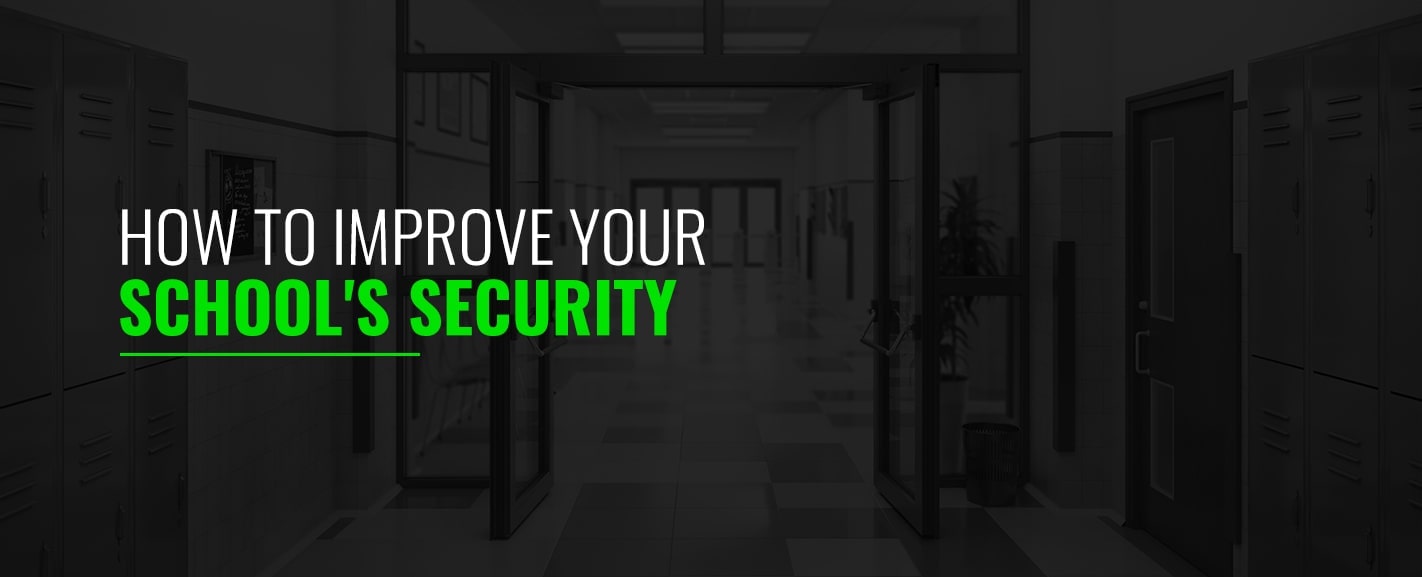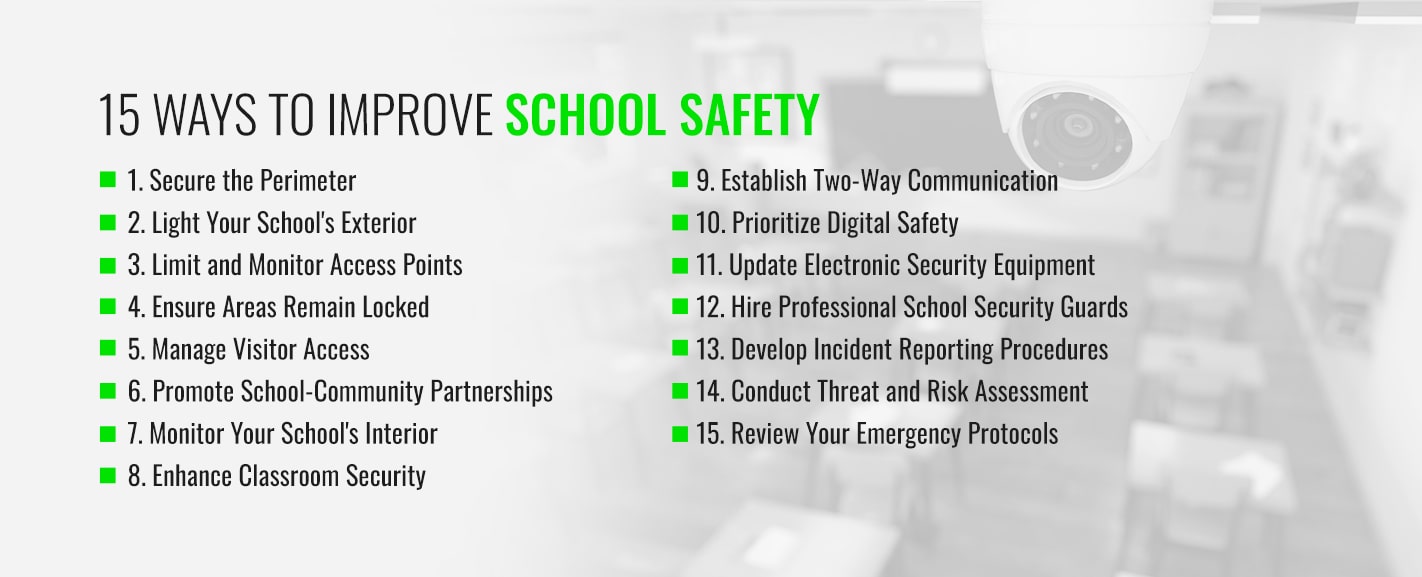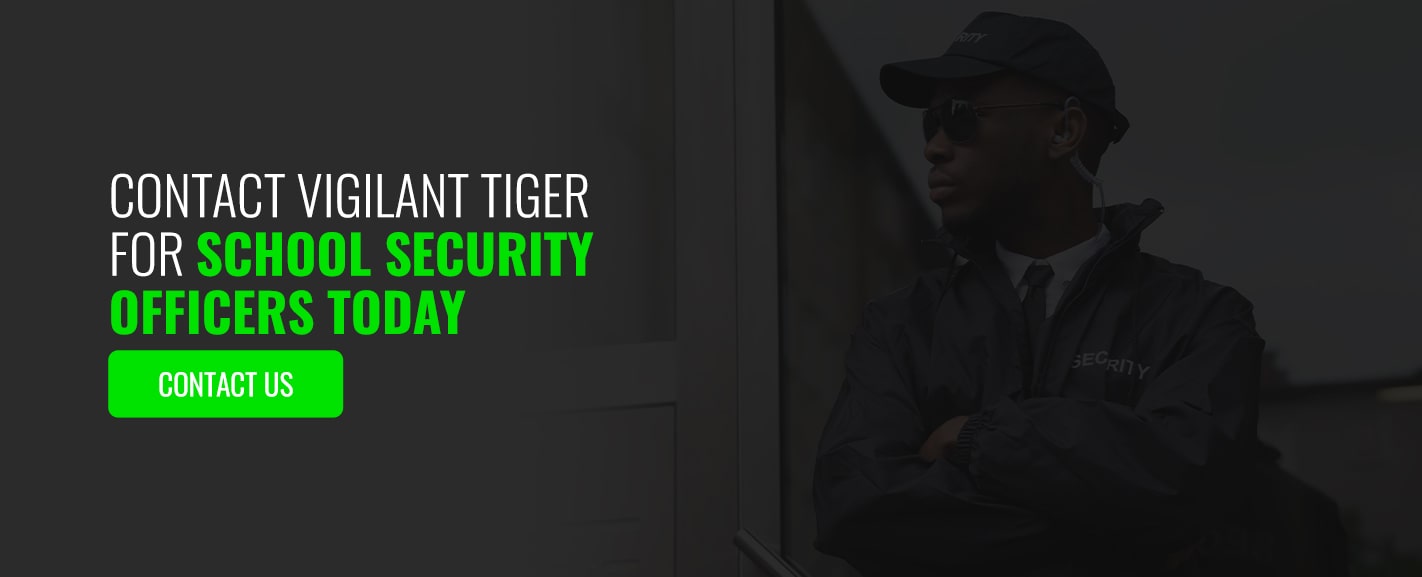
How to Improve Your School’s Security
September 2, 2021

A school security breach can affect the lives of students, teachers, staff and parents. It endangers those present in the building, but can also impact learning quality and increase the risk of lawsuits. It is the school administration’s responsibility to protect students and staff.
How can we improve school security? There are many answers to this question. Consider implementing these general ideas, which have successfully made across America safer.

15 Ways to Improve School Safety
If you are a school administrator, you should increase school security to the best of your capabilities — whether these changes include facilities management techniques, organizational emergency protocols or affordable equipment.
1. Secure the Perimeter
To ensure safety in schools, you must consider the property’s interior and exterior. Student drop-off zones and designated parking lots are essential areas you want to secure, using perimeter barriers as appropriate. Incorporate fences and gates into your school’s perimeter to maximize safety, whether school is in session or closed.
Parents, carpool drivers and buses require designated student loading and unloading zones. Post signs and communicate policies that prohibit unauthorized vehicles in these areas. That way, the school has more access control.
A security guard or video surveillance should monitor school parking lots 24/7. Designate different parking lots for staff, students and visitors, and incorporate an identification system to oversee activity in these specific areas. It’s also a best practice to keep visitor parking separate from any student drop-off zones.
2. Light Your School’s Exterior
Install adequate lighting in all surrounding areas to protect students, staff and the building itself no matter the time of day. Use automated and programmable lighting control technology to ensure sufficient visibility in covered walkways and other naturally dark areas.
Set programmable lights to turn on simultaneously each evening when after-school activities may still be taking place. Use motion sensors that automatically turn on to help prevent trip-and-fall accidents. Pair these automated lights with video surveillance to discourage trespassers or others with even worse intentions.
3. Limit and Monitor Access Points
Limit the number of access doors into the building. To optimize security, establish one main entrance for all student, staff and visitor use. Keep the rest of the access doors locked, and inspect them periodically to ensure nobody has tampered with them or propped them open.
Schools that need more than one usable entry for students and staff should post clear signage redirecting visitors to the main entrance. These techniques and protocols streamline the monitoring process so you can keep better track of who enters and leaves the premises. Exits are subject to building capacity and fire code requirements, but you must take precautions to prevent anyone from using these exits as unofficial entry points.
Ensure your school is safe in any emergency with quick exits for fire safety and secure entryways for intruder prevention.
4. Ensure Areas Remain Locked
In addition to monitoring entrances and exits, keep unoccupied areas of the school closed off and locked when not in use. Prohibit trespassing in locked parts of the building.
Implement a key control system to effectively manage all keys and duplicates. Limit the number of individuals responsible for locking and unlocking the building. Test door locks and electronic access equipment semiannually, and change any locks with unaccounted-for keys.
5. Manage Visitor Access
Schools can improve security measures by enforcing stringent visitor check-in procedures for scheduled and unscheduled appointments. All guests must sign in at the front reception or security desk so that you can closely monitor the visitor log throughout the day. Require visitors to have school-issued identification — for example, security at private schools often involves limited-time visitor badges.
Train your security officers to look for strangers without the necessary badge or other identification. Escort guests to their destination once they’ve signed in and donned a visitor badge.
6. Promote School-Community Partnerships
Security communities like neighborhood watch programs and police surveillance can enhance your safety protocols for students outside the school premises. Ask parents to take a part-time position on the security team or help establish worthwhile community partnerships.
7. Monitor Your School’s Interior
Post signs throughout the building interior to indicate that visitors must register their presence. Single out the main reception, security office or other visitor check-in areas. Perform periodic inspections on all critical utility systems, server rooms, custodial storage closets and roof access points to ensure they remain locked.
Place security personnel and surveillance cameras in enclosed stairways and common areas like hallways, cafeterias and playgrounds. The monitor keeps constant supervision and discourages unwanted behavior, while video surveillance records anything they might miss.
8. Enhance Classroom Security
Classroom doors should lock from the inside. An automatic locking system will help establish classroom safe zones and protection areas. Classroom windows and doors with glass components should have some covering that can quickly block a trespasser’s vision.
Provide teachers, students and staff with adequate security information and training. Faculty should arrange seating to allow for rapid exits in an emergency. Students should understand the importance of school safety procedures. Encourage positive discussion between students and staff members about security issues, so everyone is on the same page.
9. Establish Two-Way Communication
A two-way communication system connects all faculty, staff, administrators and security personnel. All classrooms should have a microphone and speaker connecting them to the security office. Consider incorporating panic button technology — hired security officers and first responders can react to emergencies even more quickly.
Keep the local law enforcement informed of the security systems in place at your school. Provide regular updates whenever you change the emergency protocols.
10. Prioritize Digital Safety
Technology has become a valuable tool in many classroom environments, but these benefits bring additional safety concerns you must address. School administrators must understand and promote safe internet usage. New programs that prioritize digital safety can significantly impact students’ mental health. Reduce the risk of online bullying and prevent exposure to inappropriate or disturbing content.
11. Update Electronic Security Equipment
Protect the school inside and out with video surveillance, burglar alarms and access control systems. Inspect your electronic security equipment monthly to ensure timely repairs and replacements.
12. Hire Professional School Security Guards
The presence of hired school security guards and local police officers is an essential measure toward discouraging violence and criminal behavior on school grounds.
13. Develop Incident Reporting Procedures
Encourage students to play a role in maintaining their school’s safety and security. Provide counseling services where students can open up about their problems. Start an anonymous reporting system to support students who may feel too uncomfortable or frightened to come forward. Use student hotlines, “tell an adult” campaigns and suggestion boxes to collect student feedback. Update your security measures based on frequent or pressing concerns.
14. Conduct Threat and Risk Assessment
Use specialized teams to conduct a threat and risk assessment and define proper procedures based on the findings. Improve student and staff protection against assaults, fights, bullying, theft, robbery, weapon use, sexual attacks and other violent crime.
15. Review Your Emergency Protocols
Regularly review your school’s protocols for all possible emergencies, including weather, medical, unknown intruder and armed hostage situations. School crisis plans should include preparedness procedures such as lockdowns, evacuations and emergency communications protocols.
Update your faculty preparedness training and hold simulation drills to ensure staff and students understand the emergency protocols. Violence prevention programs and zero-tolerance policies can also play a helpful role.
Why Should Schools Have Security Guards?
Security officers stationed on and around your school property are a vital part of school safety. The significant benefits of security guards in schools include the following.
- Immediate attention to emergencies: School resource officers are a constant presence in your school, meaning they can handle emergencies requiring a quick response.
- Fewer instances of violence: Armed guard services can handle hostage situations involving weapons that threaten student safety.
- Reduced bullying and fighting: Security guards act as the authority figures needed to maintain peace. Faculty already have their role as educators and may be unwilling to take charge in a different area.
- Increased observation of students: Security officers can help you keep parents informed of anything unusual or suspicious.
- Guidance for parents and staff: Students with unique needs may benefit from extra attention from your security personnel. Guards can help parents and staff handle students who may or may not need supplementary discipline.
- Expert monitoring for all access points: Hundreds or more people can come and go during the average school day. Schools should have security guards to cover all entrances and exits.
Contact Vigilant Tiger for School Security Officers Today
Our security officers have an extensive history of keeping private and specialty schools a safe space for everyone. Vigilant Tiger’s first client was a school for the blind and deaf. With over 10,000 hours of experience providing security at private schools, we care about protecting your students, teachers, staff and visitors.
Contact us today and talk to a security specialist about all your security needs in Colorado Springs. Our high-quality security guards can start as soon as you need them.

